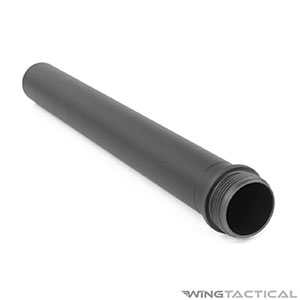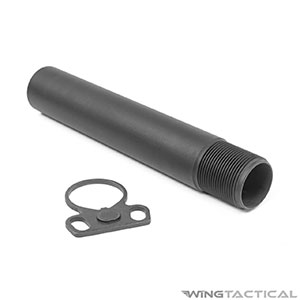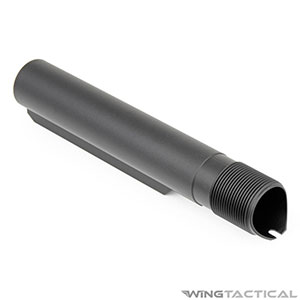For an AR-15 to work correctly, it needs to be equipped with well-fitting, high-quality parts. A vital part of any AR's function is the buffer tube — also known as a receiver extension — so finding the right fit for your firearm is necessary.
At Wing Tactical, we provide our customers with the products and knowledge they need to enhance their AR-15 and have a fantastic shooting experience. Whether you’re looking for a carbine buffer tube, an AR pistol buffer tube, or an AR-15 buffer tube assembly, you’ll find what you need in our inventory.

AR-15 Buffer Tube Assembly: Everything You Need to Know
Whether you're assembling an AR-15 for the first time or have dozens of builds under your belt, it's essential to know the different lengths of buffer tubes and when you should use them. Picking the right tube will ensure you comply with the legal guidelines surrounding the AR platform and help you construct a firearm that functions smoothly and correctly.
There are three common buffer tube lengths, which are not interchangeable since each will have a corresponding buffer and gas system. Each offers different benefits for your rig. Wing Tactical offers three distinct buffer tube lengths for today’s builders:

Rifle Buffer Tubes
Rifle buffer tubes are a suitable length for a rifle gas system and don’t require an endplate. They’re typically installed on fixed-stock rifles and used with longer rifle buffers.

Pistol Buffer Tubes
Pistol-length buffer tubes are great for barrels shorter than 16 inches. They’re compatible with arm braces which stabilize and distribute the recoil force into the upper arm while firing with one hand.

Carbine Buffer Tubes
Carbine buffer tubes are a shorter option than rifle-length buffer tubes, and they’re equipped with fewer coils and an exterior rib. Carbine-length tubes are optimized for use with collapsible stocks.
Guarantees When You Shop with Wing Tactical
At Wing Tactical, we have one of the best and largest inventories of accessories and parts you'll find anywhere. We don't just sell any buffer tubes — we make sure they're worth your time and money. When you shop with us, you benefit from guarantees like:
- First-rate customer service – Our dedicated experts are gun enthusiasts too, and we'll answer all your questions along the way to help you find exactly what you need.
- Speedy shipping – Our next-day shipping helps us get your products to you fast, so you can use them when you really need them.
- Our seal of approval – We would never sell anything that our experts wouldn't use themselves — you can order here with confidence that you're getting the best.
- Satisfaction or your money back – In the rare case that you're disappointed with what you receive, you have 30 days to get a full, no-hassle refund.
Customizing your AR-15 with our high-quality buffer tubes will give you the reliability and sturdiness that you deserve. Check out what we offer and take your gun to the next level. You can also get in touch with our expert team if you need any assistance.
Frequently Asked Questions
How do you replace your buffer tube?
Our buffer tube removal guide contains more specific information, but replacing a buffer tube is generally a simple, three-step process:
- Remove the buffer and buffer spring. Push the buffer into the stock, push the retaining pin down, and slide the buffer and its spring out of the tube.
- Remove the buttstock. Maintain pressure on the spring and follow the manufacturer's directions on removing your specific buttstock. A fixed stock will likely require a large flathead screwdriver, while a collapsible model will call for a castle nut wrench or an armorer's tool.
- Remove the buffer tube by gripping it firmly and gradually turning it by hand.
Once you have your buffer tube free, you should confirm whether your lower is designed for a commercial or Mil-Spec tube to ensure a correct fit to your stock — the rear slant of a commercial tube will provide a clear giveaway.
What’s the difference between Mil-Spec and commercial buffer tubes?
Mil-Spec buffer tubes — those made to military specifications — are forged to form a single piece with rolled threads. They are commonly manufactured from 7075 alloys and measure between 1.145 to 1.150 inches in diameter, making for a thinner yet stronger design.
On the other hand, you can also find commercial tubes made from lower-grade aluminum in 6061 alloys for a more economical option. These tend to be slightly bigger than their counterparts, with cut threads instead of rolled and a slant rather than a flat at the end furthest from the receiver.
When deciding between Mil-Spec vs. commercial buffer tubes, remember that little scientific information indicates one is better than the other. The most important thing to note is that a buttstock will only fit one or the other, so make sure your buffer tube and chosen stock are compatible before purchasing either.
Which buffer tube brands does Wing Tactical carry?
At Wing Tactical, we only carry and provide the top brands to bring you the highest quality products. The buffer tube brands that we offer include:
Are rifle buffer tubes, carbine buffer tubes, and pistol buffer tubes interchangeable?
No. Since different AR platform configurations use distinct gas systems, it’s crucial that builders choose a buffer tube and components that are compatible with their rifle’s particular gas system.
Is a heavier or lighter buffer better?
Builders will discover various weighting options while shopping for buffer tube assemblies. Buffer weight can impact felt recoil, so you should choose the weight that optimizes your recoil and is compatible with the caliber your rifle is chambered in.






